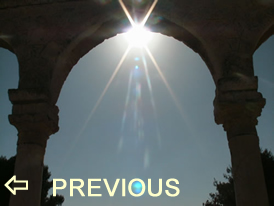|
|
|
 A Bible Teaching Ministry of Galyn Wiemers A Bible Teaching Ministry of Galyn Wiemers
|
|
|

|
| |

|
May 1 - Evening
"After all that Hezekiah had so faithfully done, Sennacherib king of Assyria came and invaded Judah. He laid siege to the fortified cities, thinking to conquer them for himself. When Hezekiah saw that Sennacherib had come and that he intended to wage war against Jerusalem, he consulted with his officials and military staff about blocking off the water from the springs outside the city, and they helped him. They gathered a large group of people who blocked all the springs and the stream that flowed through the land.
'Why should the kings of Assyria come and
find plenty of water?' they said.
Then he worked hard repairing all the broken sections of the wall and building towers on it. He built another wall outside
that one and reinforced the terraces of the City of David.
He also made large numbers of weapons and shields."
- Second Chronicles 32:1-5 |
 |
|
| Hezekiah Rebels Against Assyria and Prepares Jerusalem for a Siege |
|
|
Part of the reformation that Hezekiah was seeking included shaking loose of servitude to foreign empires such as the Assyrians and the forced religious influence the Assyrians brought to Judah. Concerning these international relationships Hezekiah rebelled against the Assyrian Emperor Shalmaneser and then turned to defeat the Philistines who had taken territory from King Ahaz and had refused to join Hezekiah’s anti-Assyrian stance. Hezekiah then watched as the Assyrians invaded Israel, his neighbors to the north, in 725 BC and defeated then defeated Israel in 721 BC. In 701 BC Sennacherib, the next Assyrian king, began attacking the fortified cities of Judah.
It was at this time Hezekiah blocked the water of the Gihon’s Springs and had his men tunnel all the way under the City of David, or Jerusalem, in order for the released waters of the Gihon Springs to flow from the east side to the west side within the protection of the city walls. Hezekiah also rebuilt the city walls of Jerusalem and repaired damaged areas in preparation for Sennacherib and his Assyrian’s troops. The tunnel, which is today called Hezekiah’s Tunnel is also mentioned in 2 Kings 20:20,
“As for the other events of Hezekiah’s reign, all his achievements and how he made the pool and the tunnel by which he brought water into the city, are they not written in the book of the annals of the kings of Judah?”-
Isaiah speaks of this construction work done by Hezekiah, but calls Hezekiah to continue to trust in the Lord in Isaiah 22:8-11:
“And you looked in that day to the weapons in the Palace of the Forest (King Solomon’s Palace of the Forest of Lebanon);
you saw that the City of David had many breaches in its defenses; you stored
up water in the Lower Pool (from Hezekiah’s Tunnel).
You counted the buildings in Jerusalem (new expansion to the west)
and tore down houses to strengthen the wall (this is what we see in the
excavation of the broad wall, which was built through houses
that had to be removed to build it).
You built a reservoir between the two walls for the water of the Old Pool, but you did not look to the One who made it, or have regard for the One who planned it long ago.”
|
|
 |
"How can we understand the Word, unless we see it in its proper chronological, historical and geographical setting?” - Andre Parrot
|
 |
According to the Jewish law harvesters can make only one pass through the fields. Anything that was missed or dropped belongs to the poor who could go out and gather the left over grain for their families. (Lev. 19:10) |
|
| |
|
|
| |
|
 |
 |
 |
 |
Sleep |
Spirit of Grace |
Business Owners |
Costa Rica |
|
|
| |
|
|
| |
| |
| |
| Reps & Sets is a daily Bible devotional for Christians from Generation Word Bible Teaching used each morning and evening. |
| |
|
|